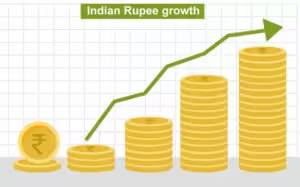
The Indian rupee recently fell to a record low of ₹88.3 per U.S. dollar, creating concern among businesses and households alike. This decline has not only alarmed investors but also sparked debates among policymakers about how best to protect the economy. Several global and domestic factors are driving this slide. Together they are shaping one of the toughest phases for the currency in recent years.
The U.S. decision to impose a 50% tariff on Indian exports has hurt foreign exchange earnings and weakened trade flows. For small and medium-sized exporters, this tariff means lower demand and shrinking profit margins. This, in turn, reduces their ability to invest and expand. This outflow not only weakens the rupee further but also shakes investor confidence in India’s short-term growth story.
Since oil imports directly affect transport, manufacturing, and energy generation, even a slight rise in prices can have a ripple effect across the entire economy. Analysts point out that this “imported inflation” is one of the biggest risks to India’s financial stability in the coming months. It could raise costs for both businesses and households.
Government and RBI Response to Rupee Decline

The government recognizes both the risks and the benefits of a weaker rupee. Exporters gain because their products become cheaper in global markets. Importers suffer as costs rise for essentials like oil, gold, and machinery. Striking a balance between these competing interests has become a key challenge for policymakers. To manage this balance, the Reserve Bank of India (RBI) has shifted its strategy in recent months.
It is reducing reliance on U.S. Treasury bills and buying more gold to diversify foreign exchange reserves. According to the Economic Times, this move aims to provide long-term stability and reduce vulnerability to sudden shifts in global finance, particularly during times of geopolitical stress.
In addition, the government is reviewing tax structures. This step could ease the burden on businesses and make compliance simpler. Additionally, it could help companies cope with global trade challenges. If implemented effectively, it may also restore some investor confidence and encourage new investment flows into the Indian economy.
What It Means for People and the Future
The fall of the rupee is not just an economic issue; it also touches daily life in ways that are both direct and indirect. Families across India are feeling the pressure on their household budgets. Many are forced to cut back on discretionary spending. Looking forward, experts believe the rupee could face more weakness if global tensions and tariffs continue. However, they also argue that India’s strong domestic demand, large consumer market, and structural reforms could act as stabilizing forces in the medium term.
Encouragingly, India’s manufacturing sector is showing strong growth. Factory outputs are reaching a 17-year high in August 2025, according to a recent Reuters report. This resilience could provide a cushion for the currency in the months ahead, as stronger industrial activity often attracts investment and builds confidence.
If India successfully negotiates relief from U.S. tariffs and strengthens its trade partnerships, the rupee may regain part of its lost value, offering much-needed relief to businesses, consumers, and policymakers alike.
Stay tuned for more updates with The World Times.



